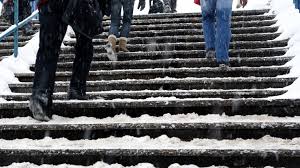Even though spring is right around the corner, winter still has a strong grip on most of the country. With this in mind, Casey & Devoti is warning people to use caution when walking on snow or ice covered driveways, sidewalks and parking lots.
It is important to note that business property owners have a duty to exercise reasonable care when it comes to maintaining these areas and promptly removing snow and ice to reduce the risk of falls and injuries. However, members of the public also have a duty to exercise reasonable care when walking in an area they know (or should reasonably expect) will be snowy and/or icy.
Each winter slips and fall accidents cause serious injuries. Many slips and falls happen in places people regard as safe and secure, typically outside their front door, on the door step, on the driveway, or while getting out of the car. During the extremely cold weather most emergency departments experience a tenfold increase in injuries due to falls as a result of the snow and icy conditions. The most typical injuries are fractures and dislocations of the wrist, shoulder and ankle.
Top Safety Tips for Pedestrians Walking on Snow and Ice:
- Even when surfaces do not look especially icy or slippery, it is very possible that a thin sheet of transparent ice or “black ice” is covering the ground. Use caution.
- If a journey cannot be avoided walk on a sidewalk, not in the street. If there are no sidewalks walk on the right hand side of the road (towards oncoming traffic). Be extremely careful as frost, ice and snow will make walking and driving dangerous.
- Remember, cars and trucks slip and slide, too. Snow and ice storms reduce visibility. Be aware of your surroundings. Keep your head up, wear bright or reflective clothing and carry a flashlight.
- Do not walk with your hands in your pockets. Walk with your hands out and wear gloves so you can break your fall if you do slip. It’s better to have a broken wrist than a fractured skull.
- Remember that sidewalks may not be treated. Wear appropriate footwear and in extreme conditions consider an appropriate walking stick or walking pole.
- If you can’t avoid the ice and snow, bend your knees slightly and take slower, shorter steps to help reduce the chance of a slip and fall and an injury.
- Wear clothing that does not restrict your vision. Stay warm, but do not impair your vision with hoodies, ski masks, scarves or hats. This type of clothing could prevent you from spotting icy conditions that may lead to a fall or not enable you to see a car that is spinning out of control.
- Use extra caution when crossing roadways and always cross at pedestrian crossings.
- It is not a good idea to go jogging in such conditions. It is surprising how many people pick up injures, each year, after falling while out jogging.
- Ice can easily hide under a light dusting of snow. Just because you don’t see the ice doesn’t mean it’s not there waiting for your unsuspecting footfalls.
- If forced to use the steps at someone’s home, apartment, or other public building, walk slow, use handrails and take shorter steps. The same is true of driveways and other hilly terrain. Steps especially can be hard to clear and build up ice easily.
- Be aware of overhead hazards. Falling icicles and chunks of snow pose a serious risk. In extreme cold weather icicles can build up in size very quickly and are lethal. Their size and dagger-like formation are extremely dangerous for pedestrians. Be aware of what’s happening above you, and stay clear from the edges of buildings.








